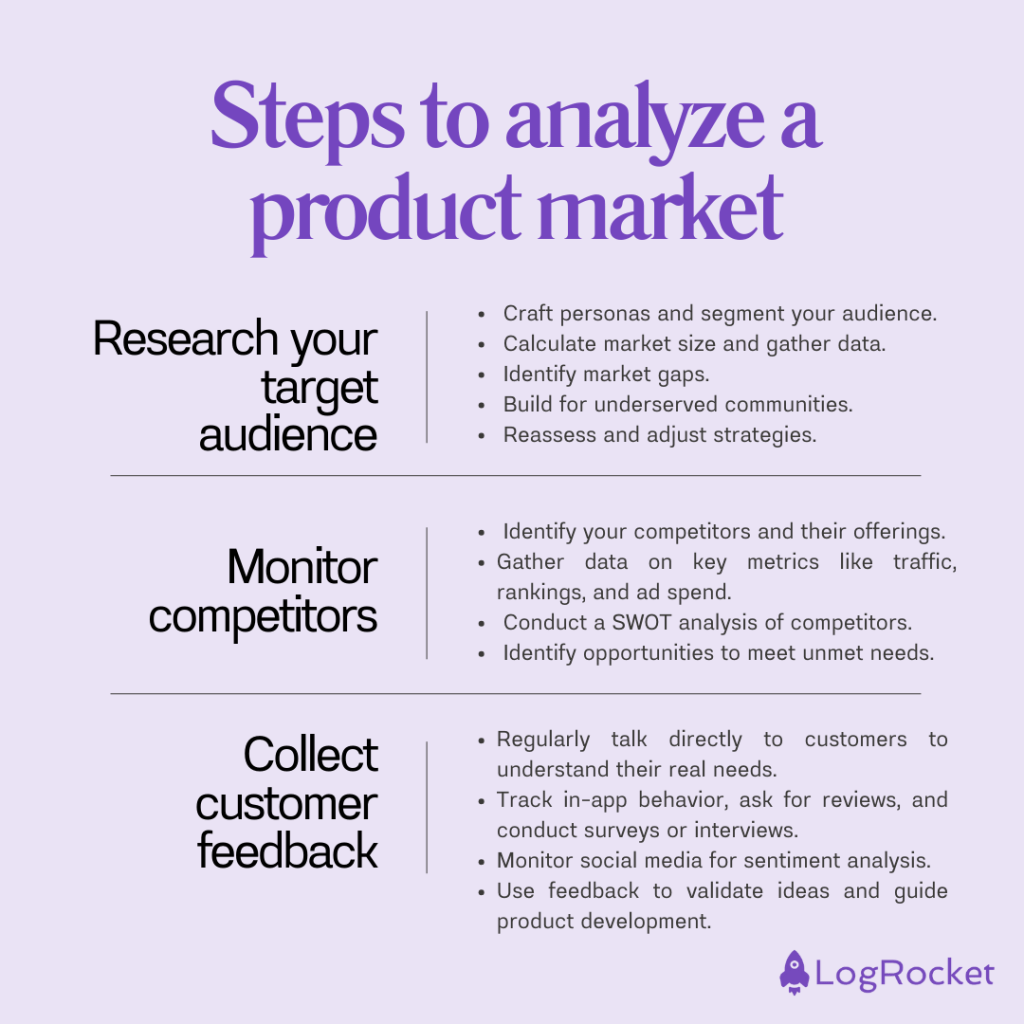
The core of product management is your target market. As a product manager, you hold the key to bridging the gap between an audience’s needs and your company’s product. Achieving product-market fit is non-negotiable in a competitive landscape.
In this article, I explore the concept of product markets, its significance in product management, and strategies to align products with target markets.
In product management, the product market refers to the specific target customers a product is designed to serve. A product should aim toward serving the underserved needs of the target audience.
Creating a product that serves the needs of everyone is a mistake. Attempting this can make it difficult to develop a product that has a useful purpose. Marketing will also have a hard time deploying a strategy that resonates with an audience.
Instead, as a product manager, you need to have a thorough understanding of the market, trends, and target audience. Once you know an audience’s demographics and psychographics, you can find their underserved needs. That’s the sweet spot to bridge the gap between a customer’s need and a valuable product.
Product market analysis is a crucial part of making informed business decisions. Before beginning product development, you need to know the product market.
When I begin looking at the product market, I want to find the answers to two questions: Who is the target audience, and what are their underserved needs? Without these answers, it’s impossible to find a product-market fit.
For example, you may discover that your market has a lot of competition. If so, it’s critical to figure out the unmet needs of your target audience. You need to find pain points that are not being addressed and create a product that solves those problems. Otherwise, you may not be able to break into the market.
Conducting a product market analysis helps you identify market gaps or places where customer needs are unmet. You can determine this by understanding your target audience and researching your competitors. Here are a few components of market analysis:
The first step is to know your market and which personas would most likely benefit from your product. You can’t build, let alone market, a product that doesn’t have a specific audience. Crafting a user persona is crucial to determining an audience’s behavior, needs, pain points, and goals.
Here are a few other things I like to think of when I conduct market research:
Ultimately, researching your target audience can help you find underserved communities or other gaps in service. Once you understand your market, you can move forward with building a product that reaches product-market fit.
Too often, a lot of emphasis is put on understanding the audience, but you mustn’t forget about your competitors. They are already serving your audience. If you want to stand out, compare your product to several competitors. Competitor analysis is crucial to identifying gaps in the market that you can leverage toward building a strong product. You’ll want to take a deep dive into their product offerings, customers, pricing, and marketing strategies.
There are several frameworks for conducting a competitor analysis. In the end, an analysis of your competitors will generally include the following steps:
Collecting customer feedback is the foundation of creating a strong product. “My number one rule is to not go too long without talking to customers. When I say talking to customers, I mean actually talking to the people who will use your products,” explains Umesh Unnikrishnan, VP of Product at Branch.
“At a big company, there’ll be people in between you and the customer — salespeople, marketers, user research people, all of whom are proxying the customer to you. But unless you talk to a real customer, you don’t really know the problem they’re facing.”
Unnikrishnan gave the example of a customer request for an iPhone app. Upon meeting with the customer, they realized that the customer didn’t need an app — they needed a scheduling feature.
Creating this feature was much easier and more cost-effective than developing a whole app. Unnikrishnan and the product team would never have discovered this if they hadn’t talked to a real customer about their problems.
Collecting feedback directly from customers is essential to discovering their needs. A few ways to gather customer feedback include:
Always stay in touch with your customers and target audience. They are valuable for validating your product idea, guiding development, and setting the foundation for sustainable business growth.

Product-market fit describes a scenario where a product fulfills the needs of a specific market segment. Some of the main benefits of achieving product-market fit include:
Without product-market fit, companies will struggle to gain traction and won’t receive any returns.
For example, ProfitWell (now part of Paddle), a business intelligence solutions provider, wanted to align new integrations with consumer demand. Specifically, the company needed to know its customers deeply and how they used its software. Third-party tools, such as LogRocket, helped track user behavior, which ProfitWell implemented. The data led to insights on user trends, which helped inform decisions about new integrations.
Product-market fit is crucial for your business. Implement these strategies to discover the needs of your target market and what products will succeed:
Beyond traditional processes, consider how AI can help identify promising markets with high potential.
Since AI can evaluate the market in real time, it can provide insights allowing marketers to quickly adapt their strategies. These strategies may include altering product messaging, targeting different yet receptive audience segments, and predicting new trends.
By leveraging AI in product strategies for market research and segmentation, managers are better positioned to reach product-market fit. AI integration can help products stay responsive to market changes and ensure audiences have their needs met.
Product markets are always on a journey. Companies need to stay on top of trends to stay competitive. Leveraging trends to inform product decisions will create sustainable growth.
Stay informed by always involving customers in the development process. It will make it easier to know when to pivot to stay aligned with customer demand.

LogRocket identifies friction points in the user experience so you can make informed decisions about product and design changes that must happen to hit your goals.
With LogRocket, you can understand the scope of the issues affecting your product and prioritize the changes that need to be made. LogRocket simplifies workflows by allowing Engineering, Product, UX, and Design teams to work from the same data as you, eliminating any confusion about what needs to be done.
Get your teams on the same page — try LogRocket today.

Most teams fail at autonomy. Learn how clear rules help product teams move faster without micromanagement.

A practical framework for PMs to use AI in ideation without sacrificing judgment, strategy, or decision quality.

A practical five minute revenue estimation method to help product managers compare ideas, drop low impact features, and prioritize smarter.

A practical guide for PMs who want to stop being bottlenecks, delegate smarter, and lead teams effectively with a clear ownership framework.